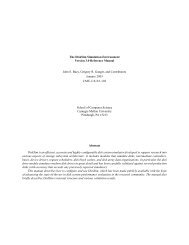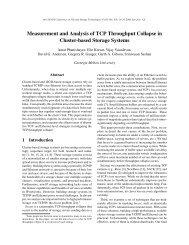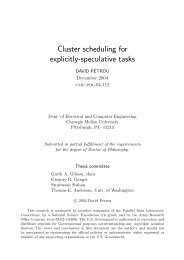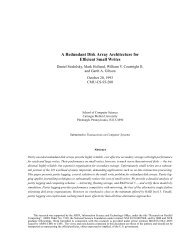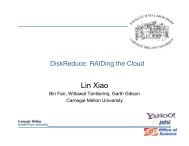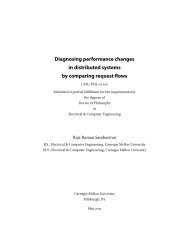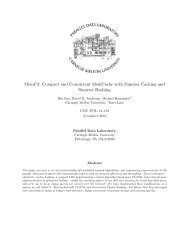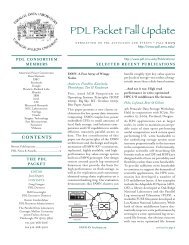Matching Application Access Patterns to Storage Device ...
Matching Application Access Patterns to Storage Device ...
Matching Application Access Patterns to Storage Device ...
You also want an ePaper? Increase the reach of your titles
YUMPU automatically turns print PDFs into web optimized ePapers that Google loves.
16 · <strong>Matching</strong> <strong>Application</strong> <strong>Access</strong> <strong>Patterns</strong> <strong>to</strong> S<strong>to</strong>rage <strong>Device</strong> Characteristics<br />
I/O operation [IBM Corporation 2000], and the DB2 STRIPED CONTAINERS parameter<br />
instructs the s<strong>to</strong>rage manager <strong>to</strong> align I/Os on stripe boundaries. Database<br />
s<strong>to</strong>rage managers complement DBA knob settings with methods that dynamically<br />
determine the I/O efficiency of differently-sized requests by issuing I/Os of different<br />
sizes and measuring their response time. Unfortunately, these methods are<br />
error-prone and often yield sub-optimal results. These mechanisms are also quite<br />
sensitive and prone <strong>to</strong> human errors. In particular, high-level generic parameters<br />
make it difficult for the s<strong>to</strong>rage manager <strong>to</strong> adapt <strong>to</strong> the device-specific characteristics<br />
and dynamic changes <strong>to</strong> workload. This results in inefficiency and performance<br />
degradation.<br />
2.3.3 Extending s<strong>to</strong>rage interfaces<br />
Many works demonstrated how extending s<strong>to</strong>rage interfaces with functions that<br />
expose information about device specifics can improve application performance.<br />
The following paragraphs discuss three specific aspects of this research that include<br />
the freedom <strong>to</strong> rearrange requests <strong>to</strong> improve aggregate performance and better<br />
utilization of resources by exposing some additional information about s<strong>to</strong>rage<br />
organization.<br />
Masking access latency<br />
Recent efforts have proposed mechanisms that exploit freedom <strong>to</strong> reorder s<strong>to</strong>rage<br />
accesses in order <strong>to</strong> mask access latency. S<strong>to</strong>rage latency estima<strong>to</strong>r descrip<strong>to</strong>rs<br />
estimate the latency for accessing the first byte of data and the expected bandwidth<br />
for subsequent transfer [VanMeter 1998]. Steere [1997] proposed a construct, called<br />
a set itera<strong>to</strong>r, that exploits asynchrony and non-determinism in data accesses <strong>to</strong><br />
reduce aggregate I/O latency. The River projects use efficient streaming from<br />
distributed heterogeneous nodes <strong>to</strong> maximize I/O performance for data-intensive<br />
applications [Arpaci-Dusseau et al. 1999; Mayr and Gray 2000].<br />
Other research has exploited similar ideas at the file system level. Parallel file<br />
systems achieve higher I/O throughput from the underlying, inherently parallel,<br />
hardware [Freedman et al. 1996; Krieger and Stumm 1997]. As demonstrated by<br />
Kotz [1994], a parallel file system rearranging application requests in<strong>to</strong> larger, more<br />
efficient I/Os <strong>to</strong> individual disks provides significant improvements <strong>to</strong> scientific<br />
workloads. Similarly, I/O request criticality annotations based on file system and<br />
application needs provide greater scheduling flexibility at the s<strong>to</strong>rage subsystem<br />
level, resulting in better application performance [Ganger 1995].



